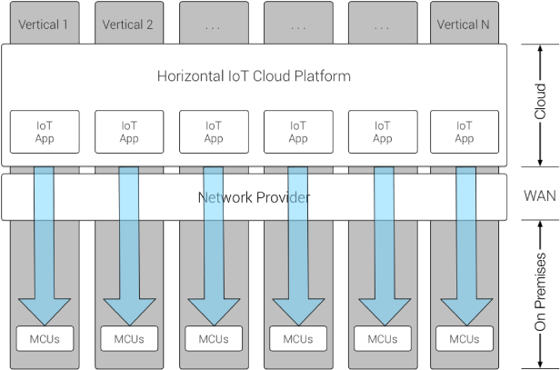Few companies today have the expertise to build a complete IoT application to compete in the emerging market for real-time services. A bifurcated development model accelerates the timeline to deliver solutions for real-world operational problems.
The proposed IoT framework was previously described, including the five layers of the IoT technology stack. Managing the complexity of the five layers of technology (device hardware, device software, communications, cloud platform, and cloud applications) can be daunting.

The Bifurcated IoT Development Model
In the five-layer proposed framework, the two layers to the right (Cloud Platform and Cloud Applications) represent the familiar territory of SaaS Application developers. Much less familiar today are the three layers to the left (Device Hardware, Device Software, and Communications), which represent the focus of much IoT discussion today. Relatively speaking, SaaS Application development leads the way with familiarity, while IoT device hardware/software/communication remains a relative mystery.
This state of affairs explains the rise of horizontal IoT cloud platforms. As illustrated, IoT cloud platforms such as those commercialized by AWS, Microsoft Azure, and Google Cloud enable the creation of IoT SaaS Applications in specific market verticals.

Being agnostic to the data application, horizontal IoT cloud platforms have provided IoT cloud tools to accelerate IoT SaaS Applications across industries. Presumably, SaaS Application developers that leverage those IoT cloud tools would apply their domain expertise to create industry-specific analytics that represent informational insights from IoT data. In a sense, subject matter experts (SMEs) would have institutional knowledge, which would represent the value-added portion of the SaaS Application built on the horizontal IoT cloud platform.
Filling in the Bottom of the IoT Technology Stack
To provide a truly turn-key service to enable rapid SaaS Application development built on IoT data, horizontal IoT cloud platforms have sought to provide the tools to ingest relevant IoT data. In other words, they have tried to fill in the first three layers of the IoT technology stack (i.e., device hardware, device software, and communications).
IoT cloud platforms have therefore continued to expand with their integrated support of inexpensive microcontrollers (MCUs) for embedded sensing and control. AWS introduced Amazon FreeRTOS, which is an IoT operating system for MCUs to securely connect to AWS IoT Core. The AWS partner device catalog includes 14 evaluation and development kits that can prototype MCU-based IoT solutions. Similarly, Microsoft Azure introduced Azure Sphere, their version of an IoT operating system for MCUs to securely connect to Azure IoT Hub. Finally, Google Cloud has worked with their partners to build a number of starter kits to make it easy for developers to connect to Cloud IoT Core.

IoT cloud platforms are extending their reach to the premises via MCUs tools that will satisfy the first three layers of the IoT technology stack. The level of integration varies, but the intent becomes clear. If they can provide a comprehensive suite of IoT development tools of the first three layers of the IoT technology stack, then rapid IoT Application development can occur through mature SaaS Application development ecosystems.
The Missing Piece: Turn-Key IoT Device Hardware
MCU-based development and prototyping kits are available to generate IoT device hardware that is tightly integrated with Cloud services. While much improved over previous generations of IoT device hardware that was not integrated with Cloud services, development expertise is lacking at the device hardware and device software layers of the IoT technology stack. In other words, IoT Application development requires expertise at both ends of the IoT technology stack (i.e., IoT device hardware and Cloud Applications). This represents a stumbling block and impediment to IoT Application development.
What is still needed is turn-key IoT device hardware and device software that is solution ready. In other words, horizontal IoT cloud platforms are still pursuing IoT device hardware and device software solutions that are ready out-of-the-box to gather real-time data streams needed for particular SaaS applications across industries. This will effectively create a turn-key data service made available to IoT Application developers across various industries.
When such a feature becomes available, then a prominent obstacle to IoT application development will be removed. Expect rapid advancement in the spread of IoT applications across industries when that occurs.
Conclusion
The bifurcated IoT development model is coming. Horizontal IoT cloud providers inherently recognize the need as they continue to push down the IoT technology stack from the cloud to IoT device hardware. Out-of-the-box solutions of the entire technology stack beneath the SaaS Application layers are on the horizon.

